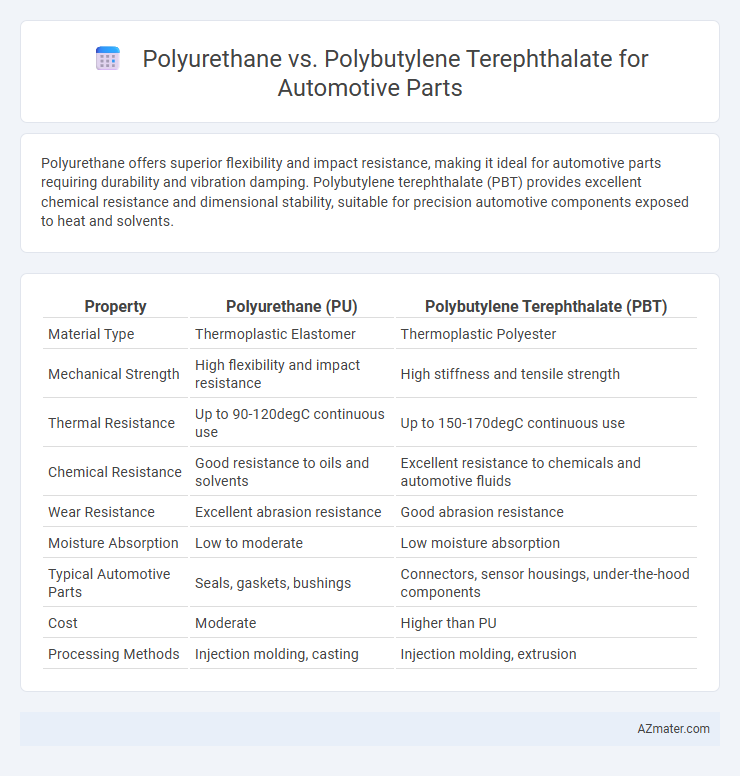Polyurethane offers superior flexibility and impact resistance, making it ideal for automotive parts requiring durability and vibration damping. Polybutylene terephthalate (PBT) provides excellent chemical resistance and dimensional stability, suitable for precision automotive components exposed to heat and solvents.
Table of Comparison
| Property | Polyurethane (PU) | Polybutylene Terephthalate (PBT) |
|---|---|---|
| Material Type | Thermoplastic Elastomer | Thermoplastic Polyester |
| Mechanical Strength | High flexibility and impact resistance | High stiffness and tensile strength |
| Thermal Resistance | Up to 90-120degC continuous use | Up to 150-170degC continuous use |
| Chemical Resistance | Good resistance to oils and solvents | Excellent resistance to chemicals and automotive fluids |
| Wear Resistance | Excellent abrasion resistance | Good abrasion resistance |
| Moisture Absorption | Low to moderate | Low moisture absorption |
| Typical Automotive Parts | Seals, gaskets, bushings | Connectors, sensor housings, under-the-hood components |
| Cost | Moderate | Higher than PU |
| Processing Methods | Injection molding, casting | Injection molding, extrusion |
Introduction to Polyurethane and Polybutylene Terephthalate
Polyurethane is a versatile polymer known for its exceptional flexibility, abrasion resistance, and impact strength, widely used in automotive interiors and exterior components for enhanced durability and comfort. Polybutylene terephthalate (PBT) is a thermoplastic polyester recognized for its excellent chemical resistance, high dimensional stability, and electrical insulation properties, making it ideal for automotive electrical connectors and under-the-hood applications. Both materials offer unique mechanical and thermal advantages, influencing their selection based on specific automotive part requirements.
Material Composition and Chemical Structure
Polyurethane consists of repeating units of urethane linkages formed by the reaction of isocyanates and polyols, providing flexible, lightweight properties ideal for automotive interior parts and cushioning applications. Polybutylene terephthalate (PBT) is a semi-crystalline thermoplastic polyester composed of butylene glycol and terephthalic acid, offering high mechanical strength, chemical resistance, and dimensional stability suited for under-the-hood components. The distinct chemical structures influence their thermal stability, with PBT exhibiting higher heat resistance compared to the more elastomeric polyurethane.
Mechanical Properties Comparison
Polyurethane offers exceptional flexibility, high tensile strength, and superior abrasion resistance, making it ideal for automotive parts requiring impact absorption and vibration damping. Polybutylene terephthalate (PBT) provides excellent dimensional stability, high rigidity, and superior chemical resistance, suitable for components exposed to heat and aggressive automotive fluids. When compared, polyurethane excels in elasticity and durability under dynamic stress, while PBT outperforms in stiffness and thermal resistance for structural applications.
Thermal Stability and Heat Resistance
Polyurethane offers excellent thermal stability with a continuous use temperature up to 90-110degC, making it ideal for flexible automotive components exposed to moderate heat. Polybutylene terephthalate (PBT) exhibits superior heat resistance, maintaining structural integrity at continuous temperatures around 130-150degC, suitable for under-the-hood parts requiring higher temperature endurance. The choice between polyurethane and PBT depends on whether flexibility or higher thermal resistance is prioritized in automotive part applications.
Durability and Wear Performance
Polyurethane offers superior abrasion resistance and elasticity, making it highly durable under dynamic automotive conditions, while polybutylene terephthalate (PBT) excels in stiffness and dimensional stability but is more prone to wear under continuous friction. The high impact strength and flexibility of polyurethane contribute to enhanced wear performance in applications subject to vibration and shock. PBT's resistance to chemical exposure complements its mechanical properties, yet polyurethane remains favorable for parts requiring prolonged durability against mechanical stress and surface degradation.
Weight and Density Considerations
Polyurethane typically features a lower density than polybutylene terephthalate (PBT), making it advantageous for lightweight automotive parts aimed at improving fuel efficiency. PBT, with its higher density and excellent mechanical strength, is preferred for components requiring rigidity and thermal stability. Selecting between polyurethane and PBT depends on balancing weight reduction goals against durability and performance requirements in automotive applications.
Cost Analysis for Automotive Applications
Polyurethane offers cost advantages in automotive applications due to its lower raw material and processing expenses compared to polybutylene terephthalate (PBT), which typically involves higher polymerization and molding costs. While PBT provides superior chemical resistance and mechanical strength, the initial investment and cycle times in manufacturing make polyurethane more economical for high-volume, flexible parts. Evaluating long-term cost implications requires balancing polyurethane's lower upfront costs against PBT's durability and potential reduction in warranty and replacement expenses.
Processing and Manufacturing Techniques
Polyurethane offers versatile processing options such as injection molding, reaction injection molding (RIM), and casting, enabling complex shapes and fine surface finishes suitable for automotive components like seals and interior parts. Polybutylene terephthalate (PBT) is primarily processed through injection molding, favoring high production volumes due to its fast crystallization rate and excellent dimensional stability, ideal for electrical connectors and under-the-hood applications. Both materials benefit from advanced manufacturing techniques, but PBT's thermal resistance and ease of automation often provide cost-effective production for precision automotive parts compared to the more flexible but slower processing of polyurethane.
Common Automotive Parts Using Each Material
Polyurethane is commonly used in automotive parts such as bushings, seals, and interior trim components due to its excellent flexibility, abrasion resistance, and shock absorption. Polybutylene terephthalate (PBT) is widely utilized for under-the-hood components like connectors, switches, and fuel system parts because of its high mechanical strength, chemical resistance, and thermal stability. The choice between polyurethane and PBT depends on the specific performance requirements, with polyurethane favored for flexible, impact-resistant parts and PBT preferred for rigid, heat-resistant applications.
Environmental Impact and Sustainability
Polyurethane automotive parts offer greater sustainability due to their durability and potential for recycling, reducing waste and resource consumption, while polybutylene terephthalate (PBT) provides excellent chemical resistance and mechanical strength, yet its production relies heavily on petroleum-based raw materials, raising environmental concerns. The biodegradability of polyurethane is generally low but improvements in bio-based polyurethanes enhance their environmental profile compared to PBT, which is less recyclable and contributes more to plastic pollution. Selecting polyurethane can thus reduce carbon footprint and landfill dependency in automotive applications, making it a more sustainable option when considering the full lifecycle analysis.

Infographic: Polyurethane vs Polybutylene terephthalate for Automotive part
 azmater.com
azmater.com